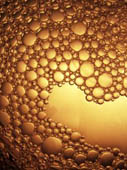
Purpose
To demonstrate the process of osmosis
Additional information
Osmosis is the process by which solutions of different concentrations move across semi-permeable membranes from the region of lower concentration into that of higher concentration. Osmotic pressure is the force with which molecules move from the area of its higher concentration into that of its lower concentration.
Sponsored Links
Required materials
- Beaker or transparent glass / plastic bowl
- Thistle funnel – a transparent glass funnel with a long, calibrated tube
- Concentrated sugar solution
- Distilled water
- Semi permeable membrane such as parchment paper or cellophane
- Twine to secure the membrane to the mouth of the Thistle funnel
- Stand with a clamp to hold the Thistle funnel in position
Estimated Experiment Time
Approximately 10 minutes to set up the apparatus and 2-3 hours thereafter to make the observations.
Step-By-Step Procedure
- 1. Fit a semi-permeable membrane carefully over the mouth of a thistle-funnel with the help of strong twine.
- 2. Invert the funnel so that the covered mouth is at the bottom and fill the cup of the funnel with concentrated sugar solution.
- 3. Fill the beaker with distilled water and then immerse the funnel containing the concentrated sugar solution into it with the membrane-covered portion towards the base of the beaker.
- 4. Clamp the tube of the thistle-funnel in a vertical position leaving a gap between its covered mouth and the base of the beaker.
- 5. Mark the level of sugar solution in the tube of the Thistle funnel and leave for some time.
Note
The beaker can be filled three-fourths with distilled water while the Thistle funnel must have ample space left empty in its tube for the level of the solution to rise in course of the observation phase of this experiment.
Observation
The level of the solution in the funnel’s tube rises and the membrane bulges out towards the base of the beaker containing it.
Result
The rise in the level of the solution in the Thistle funnel tube is owing to the movement of water molecules into the funnel. This is because distilled water has a weaker concentration as compared to the concentrated sugar solution and the water molecules tend to move from areas of its higher concentration into those of its lower concentration.
Sponsored Links
Take a moment to visit our table of Periodic Elements page where you can get an in-depth view of all the elements,
complete with the industry first side-by-side element comparisons!